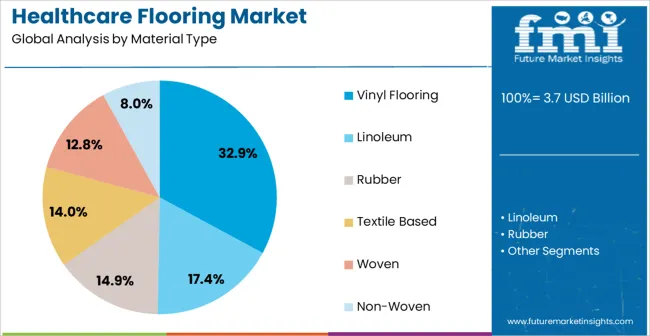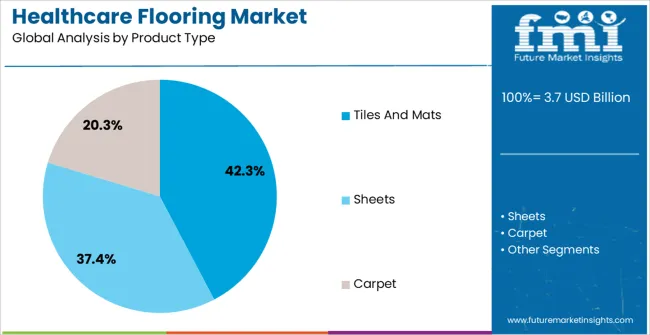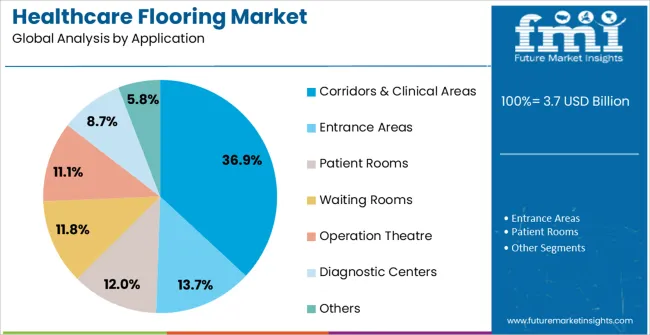The Healthcare Flooring Market is estimated to be valued at USD 3.7 billion in 2025 and is projected to reach USD 6.6 billion by 2035, registering a compound annual growth rate (CAGR) of 6.0% over the forecast period.

| Metric | Value |
|---|---|
| Healthcare Flooring Market Estimated Value in (2025 E) | USD 3.7 billion |
| Healthcare Flooring Market Forecast Value in (2035 F) | USD 6.6 billion |
| Forecast CAGR (2025 to 2035) | 6.0% |
The Healthcare Flooring market is experiencing steady expansion, supported by the increasing demand for durable, safe, and hygienic flooring solutions in medical facilities. Rising investments in healthcare infrastructure, combined with stricter regulations around infection control and patient safety, are shaping the industry landscape. Hospitals, clinics, and specialized care centers are increasingly prioritizing flooring materials that minimize contamination risks while ensuring comfort for patients and staff.
Technological advancements have led to the introduction of antimicrobial coatings, slip-resistant designs, and eco-friendly materials, all of which are enhancing adoption. Additionally, flooring solutions are being tailored to meet the unique requirements of different healthcare settings, from surgical rooms to corridors and waiting areas. Growing awareness about sustainability and energy efficiency is encouraging the use of recyclable and low-emission products.
As the global healthcare sector continues to expand due to rising patient volumes and aging populations, the demand for specialized flooring that combines durability, hygiene, and aesthetic appeal is projected to rise significantly The market is set to maintain long-term growth momentum, supported by innovation and compliance-driven adoption.
The healthcare flooring market is segmented by material type, product type, application, and geographic regions. By material type, healthcare flooring market is divided into Vinyl Flooring, Linoleum, Rubber, Textile Based, Woven, and Non-Woven. In terms of product type, healthcare flooring market is classified into Tiles And Mats, Sheets, and Carpet. Based on application, healthcare flooring market is segmented into Corridors & Clinical Areas, Entrance Areas, Patient Rooms, Waiting Rooms, Operation Theatre, Diagnostic Centers, and Others. Regionally, the healthcare flooring industry is classified into North America, Latin America, Western Europe, Eastern Europe, Balkan & Baltic Countries, Russia & Belarus, Central Asia, East Asia, South Asia & Pacific, and the Middle East & Africa.

The vinyl flooring material type segment is projected to hold 32.9% of the Healthcare Flooring market revenue share in 2025, positioning it as the leading material type. Its dominance is being driven by the versatility, cost-effectiveness, and durability of vinyl, making it particularly suitable for healthcare environments that demand high performance under heavy usage. Vinyl flooring is highly resistant to stains, chemicals, and moisture, which supports infection control and reduces maintenance costs for hospitals and clinics.
The wide availability of designs and finishes enables facilities to balance functionality with aesthetics, contributing to a better patient experience. Furthermore, vinyl flooring offers enhanced comfort underfoot and acoustic properties, reducing noise levels in busy healthcare settings. Recent innovations such as antimicrobial surfaces and improved resilience further strengthen its appeal.
As healthcare institutions seek sustainable and long-lasting solutions, vinyl flooring continues to stand out for its balance of affordability and performance Its strong adaptability across diverse medical facilities ensures that this material type will maintain its leadership in the market.

The tiles and mats product type segment is anticipated to account for 42.3% of the Healthcare Flooring market revenue share in 2025, making it the dominant product type. Growth is being driven by the ease of installation, modularity, and design flexibility offered by tiles and mats. These flooring solutions allow for rapid replacements of damaged sections, minimizing downtime and ensuring uninterrupted facility operations.
Their ability to integrate anti-slip and antimicrobial properties makes them highly suitable for clinical settings where hygiene and safety are paramount. Additionally, tiles and mats offer superior durability and can withstand the high foot traffic common in healthcare institutions. The wide variety of colors and patterns also enables facilities to create visually appealing environments that promote patient well-being and reduce stress.
Hospitals and clinics are increasingly investing in tiles and mats due to their cost efficiency and adaptability across corridors, waiting areas, and patient rooms As healthcare facilities expand globally, the demand for modular and easy-to-maintain flooring options is expected to keep the tiles and mats segment at the forefront of the market.

The corridors and clinical areas application segment is expected to capture 36.9% of the Healthcare Flooring market revenue share in 2025, establishing itself as the leading application segment. This leadership is attributed to the high traffic levels and strict hygiene requirements in these spaces, which demand flooring solutions that combine durability, safety, and ease of cleaning. Corridors serve as primary pathways for patients, staff, and equipment, making slip resistance and wear resistance critical performance attributes.
Similarly, clinical areas require surfaces that support infection control and comply with healthcare regulations. Flooring used in these areas is increasingly incorporating features such as antimicrobial coatings, noise reduction properties, and improved ergonomics to enhance both safety and comfort.
The ability to withstand continuous cleaning with strong disinfectants without deterioration is also a key factor driving adoption As healthcare facilities expand and modernize, corridors and clinical areas remain central to design considerations, ensuring that this segment retains its dominant share of the market.
Healthcare industry has witnessed several historic changes owing to strong demand for eliminating slips & falls, noise reduction, maintaining clean appearance, dust free creating a hygienic environment in hospitals and other acute care facilities, enhancing the facility design and management.
The healthcare flooring promote well-being and health of staffs and patients by offering low - maintenance products and long - lasting products suited for every space including resistance to indentations from static load, and coordinating designs & colors across categories to fit any aesthetic from warm and homey to clean and modern.
Furthermore, prominent players are offering specific products for patient rooms that are less institutional and more home - like to reduce patient’s stress and speed up the healing process during their stay. Moreover, hospitals believe that the balanced choice flooring selections keep the space quiet, comfortable, and safe, which can be availed by power bond hybrid sheet flooring which allows quieter environment improving staff morale and patient care through offering noise reduction coefficient.

| Country | CAGR |
|---|---|
| China | 8.1% |
| India | 7.5% |
| Germany | 6.9% |
| Brazil | 6.3% |
| USA | 5.7% |
| UK | 5.1% |
| Japan | 4.5% |
The Healthcare Flooring Market is expected to register a CAGR of 6.0% during the forecast period, exhibiting varied country level momentum. China leads with the highest CAGR of 8.1%, followed by India at 7.5%. Developed markets such as Germany, France, and the UK continue to expand steadily, while the USA is likely to grow at consistent rates. Japan posts the lowest CAGR at 4.5%, yet still underscores a broadly positive trajectory for the global Healthcare Flooring Market. In 2024, Germany held a dominant revenue in the Western Europe market and is expected to grow with a CAGR of 6.9%. The USA Healthcare Flooring Market is estimated to be valued at USD 1.3 billion in 2025 and is anticipated to reach a valuation of USD 1.3 billion by 2035. Sales are projected to rise at a CAGR of 0.0% over the forecast period between 2025 and 2035. While Japan and South Korea markets are estimated to be valued at USD 177.6 million and USD 118.0 million respectively in 2025.

| Item | Value |
|---|---|
| Quantitative Units | USD 3.7 Billion |
| Material Type | Vinyl Flooring, Linoleum, Rubber, Textile Based, Woven, and Non-Woven |
| Product Type | Tiles And Mats, Sheets, and Carpet |
| Application | Corridors & Clinical Areas, Entrance Areas, Patient Rooms, Waiting Rooms, Operation Theatre, Diagnostic Centers, and Others |
| Regions Covered | North America, Europe, Asia-Pacific, Latin America, Middle East & Africa |
| Country Covered | United States, Canada, Germany, France, United Kingdom, China, Japan, India, Brazil, South Africa |
| Key Companies Profiled | Armstrong Flooring, Forbo Flooring, Polyflor, Gerflor, Flowcrete Group, Altro, Stonhard Group, RMG Polyvinyl India Limited, Marvel Vinyls, Tarkett, Responsive Industries, Trelleborg Rubber Flooring, Interface, and Mohawk Group |
The global healthcare flooring market is estimated to be valued at USD 3.7 billion in 2025.
The market size for the healthcare flooring market is projected to reach USD 6.6 billion by 2035.
The healthcare flooring market is expected to grow at a 6.0% CAGR between 2025 and 2035.
The key product types in healthcare flooring market are vinyl flooring, linoleum, rubber, textile based, woven and non-woven.
In terms of product type, tiles and mats segment to command 42.3% share in the healthcare flooring market in 2025.






Our Research Products

The "Full Research Suite" delivers actionable market intel, deep dives on markets or technologies, so clients act faster, cut risk, and unlock growth.

The Leaderboard benchmarks and ranks top vendors, classifying them as Established Leaders, Leading Challengers, or Disruptors & Challengers.

Locates where complements amplify value and substitutes erode it, forecasting net impact by horizon

We deliver granular, decision-grade intel: market sizing, 5-year forecasts, pricing, adoption, usage, revenue, and operational KPIs—plus competitor tracking, regulation, and value chains—across 60 countries broadly.

Spot the shifts before they hit your P&L. We track inflection points, adoption curves, pricing moves, and ecosystem plays to show where demand is heading, why it is changing, and what to do next across high-growth markets and disruptive tech

Real-time reads of user behavior. We track shifting priorities, perceptions of today’s and next-gen services, and provider experience, then pace how fast tech moves from trial to adoption, blending buyer, consumer, and channel inputs with social signals (#WhySwitch, #UX).

Partner with our analyst team to build a custom report designed around your business priorities. From analysing market trends to assessing competitors or crafting bespoke datasets, we tailor insights to your needs.
Supplier Intelligence
Discovery & Profiling
Capacity & Footprint
Performance & Risk
Compliance & Governance
Commercial Readiness
Who Supplies Whom
Scorecards & Shortlists
Playbooks & Docs
Category Intelligence
Definition & Scope
Demand & Use Cases
Cost Drivers
Market Structure
Supply Chain Map
Trade & Policy
Operating Norms
Deliverables
Buyer Intelligence
Account Basics
Spend & Scope
Procurement Model
Vendor Requirements
Terms & Policies
Entry Strategy
Pain Points & Triggers
Outputs
Pricing Analysis
Benchmarks
Trends
Should-Cost
Indexation
Landed Cost
Commercial Terms
Deliverables
Brand Analysis
Positioning & Value Prop
Share & Presence
Customer Evidence
Go-to-Market
Digital & Reputation
Compliance & Trust
KPIs & Gaps
Outputs
Full Research Suite comprises of:
Market outlook & trends analysis
Interviews & case studies
Strategic recommendations
Vendor profiles & capabilities analysis
5-year forecasts
8 regions and 60+ country-level data splits
Market segment data splits
12 months of continuous data updates
DELIVERED AS:
PDF EXCEL ONLINE
Healthcare Air Purifier Market Size and Share Forecast Outlook 2025 to 2035
Healthcare Regulatory Affairs Outsourcing Market Size and Share Forecast Outlook 2025 to 2035
Healthcare and Laboratory Label Industry Analysis in the United States Size and Share Forecast Outlook 2025 to 2035
Healthcare AI Computer Vision Market Size and Share Forecast Outlook 2025 to 2035
Healthcare Business Intelligence Market Size and Share Forecast Outlook 2025 to 2035
Healthcare Master Data Management Market Size and Share Forecast Outlook 2025 to 2035
Healthcare and Laboratory Label Industry Analysis in Japan Size and Share Forecast Outlook 2025 to 2035
Healthcare and Laboratory Label Industry Analysis in Western Europe Size and Share Forecast Outlook 2025 to 2035
Healthcare Contact Center Solution Market Size and Share Forecast Outlook 2025 to 2035
Healthcare Semiconductor Market Size and Share Forecast Outlook 2025 to 2035
Healthcare Cold Chain Logistics Market Size and Share Forecast Outlook 2025 to 2035
Healthcare Mobile Computers Market Size and Share Forecast Outlook 2025 to 2035
Healthcare Cloud Infrastructure Market Size and Share Forecast Outlook 2025 to 2035
Healthcare Companion Robots Market Size and Share Forecast Outlook 2025 to 2035
Healthcare Analytical Testing Services Market Size and Share Forecast Outlook 2025 to 2035
Flooring Market Size and Share Forecast Outlook 2025 to 2035
Healthcare Analytics Market Size and Share Forecast Outlook 2025 to 2035
Healthcare and laboratory labels market Size, Share & Forecast 2025 to 2035
Healthcare Contract Research Organization Market Analysis – Size, Share, and Forecast Outlook 2025 to 2035
Healthcare Chatbot Market - Growth Trends & Forecast 2025 to 2035

Thank you!
You will receive an email from our Business Development Manager. Please be sure to check your SPAM/JUNK folder too.
Chat With
MaRIA